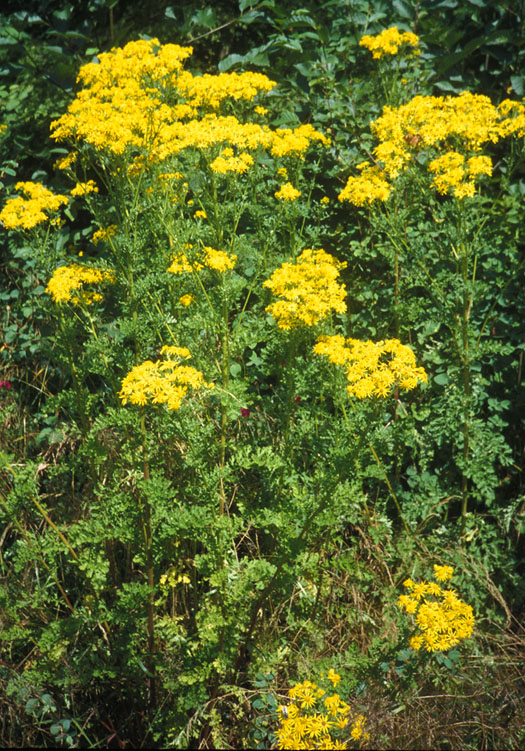
|
| Tansy Ragwort; Senecio Jacobæa L. |
Sunflower Family; COMPOSITÆ (ASTERACEÆ)
|
| The original Tansy was weed-of-the-month for February 1993. Its name-familiarity causes trouble with Tansy Ragwort. The latter,
our present villain, looks like a pretty wildflower, and botanically is a glorified Groundsel (i.e.,
Senecio vulgaris, weed-of-the-month March 1986). Beauty aside, Tansy Ragwort may be the "most serious weed pest ever known in western Washington." |
| This European plant has infested Washington since the 1920s. Its toughness, and ability to set 150,000 seeds per plant,
are not so unusual in the world of weeds. But since cattle and horses are poisoned by eating it, it is an object of concern. It is not a
matter of a few bites resulting in fatalities; much has to be consumed, over a period of time, before severe, even fatal, liver damage results. |
| Therefore, since the plant is a livestock threat, and does spread rapidly, spirited reaction against it has ensued.
Landowners who don't battle this noxious weed are committing a misdemeanor in every sense of the word. Law-enforcement, public
education, and what might be termed biologic warfare have been employed to fight Tansy Ragwort. A caterpillar that feeds on this
weed exclusively was imported from Europe. |
| Tansy Ragwort was originally called Ragwort because of its tattered, or ragged-looking leaves. Also it was called
Ragged Jack, and Stagger-wort. Because of its malodorous and other hateful qualities it was known as Stinking Willie, Mare-Fart, and
other naughty names. Understandably, this unpopular
ragwort is confused with Ragweed
(Artemisia spp.), infamous hay-fever plants. |
| The name Senecio Jacobæa, or Saint James' Weed, arose because it blossoms in abundance on the 25th of July, feast day
of St. James. At bloom time the weed can stand 3 to 5 feet tall, bearing attractive pure yellow flowers. Each flowerhead is about the
size of a quarter-dollar, with usually 12 or 13 delicate rays circling the center. All the way through October it flowers, even when
frost silvers it. |
| The plant endures dry, poor soil, withstands being trampled or yanked-up, and is only in deep distress when too much
shade envelops it. The foliage is vaguely like rue in its color and deeply dissected outline, but even more so is like that of groundsel. It
can be "cobwebbed" with silvery-white hairs. |
| In Seattle, Tansy Ragwort is not an everyday weed. You can see patches along the Burke-Gilman Trail, at Seward
Park, Golden Gardens, and in meadow or grassy fringes here and there. Learn it by sight, and kill any that appear on your property. |
It can hybridize with the garden Dusty Miller Senecio Cineraria.
|
Originally published as the Seattle Tilth newsletter Weed of the Month in September 1993, along with an illustration from a book.
Back |
|
|

